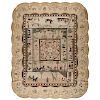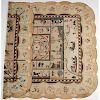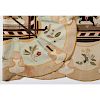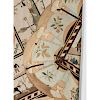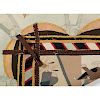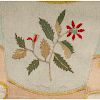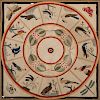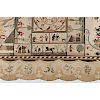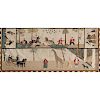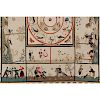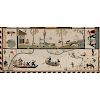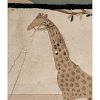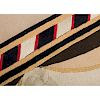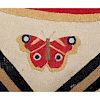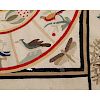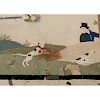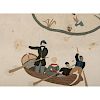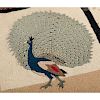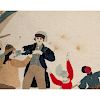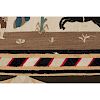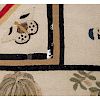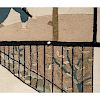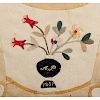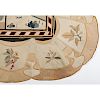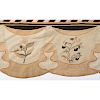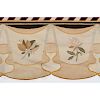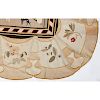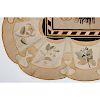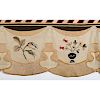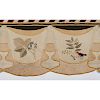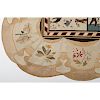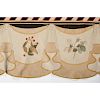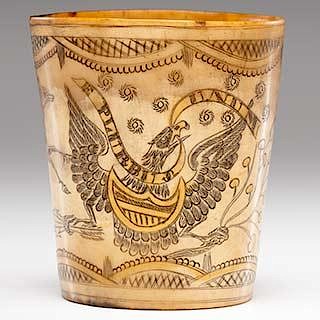A Rare 1831 English Intarsia Patchwork Pictorial Table Cover
About Seller
6270 Este Ave.
Cincinnati , OH 45232
United States
With offices in Cincinnati, Cleveland and Denver, Cowan’s holds over 40 auctions each year, with annual sales exceeding $16M. We reach buyers around the globe, and take pride in our reputation for integrity, customer service and great results. A full-service house, Cowan’s Auctions specializes in Am...Read more
Two ways to bid:
- Leave a max absentee bid and the platform will bid on your behalf up to your maximum bid during the live auction.
- Bid live during the auction and your bids will be submitted real-time to the auctioneer.
Bid Increments
| Price | Bid Increment |
|---|---|
| $0 | $25 |
| $500 | $50 |
| $1,000 | $100 |
| $2,000 | $250 |
| $5,000 | $500 |
| $10,000 | $1,000 |
| $20,000 | $2,500 |
| $50,000 | $5,000 |
| $100,000 | $10,000 |
About Auction
Mar 10, 2018 - Mar 11, 2018
Cowan's Auctions dawnie@cowans.com
- Lot Description
English, 1831. An intarsia patchwork table cover made in broadcloth, the central round medallion decorated with twelve birds and surrounded by fourteen pictorial panels, most notably a scene of a giraffe accompanied by three men in Middle Eastern dress, having a scalloped, curtain-swag border decorated with twenty-six examples of plants and flowers. Signed and dated to flower urn on border A.P. / 1831; 86 x 72 in.
The table cover offered here was made using the technique of cloth intarsia, popular in English textile production from the 1830s-1880s. The use of thick and durable wool broadcloth allows for this technique. Revealing their eagerness to demonstrate skill, and access to this material, there are extant patchwork panels created by male tailors. There is evidence, in fact, that this technique was employed almost exclusively by men in England during this time (See “A patchwork panel ‘shown at the Great Exhibition”, Dr. Clare Rose, V&A Online Journal, Issue No. 3, Spring 2011). Five superb examples of intarsia patchwork, produced by men, were exhibited in 1851 at the Great Exhibition in London. While only one of these, the Stokes Tapestry, survived intact, the Victoria and Albert Museum currently holds two other intarsia covers in its collections, along with an early 1820 appliqué patchwork with a similar, albeit more detailed, composition to the cover offered here. These examples are notable for their impressive pictorial detail, depiction of current events, and drawing inspiration from contemporary political movements, literary and visual sources.
The large lower panel depicts a giraffe standing outside a gated garden accompanied by three men, with a couple in a carriage approaching. Above this is an active scene of a lion hunt with dogs and armed men, including one man climbing a tree. This is mirrored by a European stag hunting scene on the opposite end. The long side panels depict equestrian-themed scenes: on one side, a duel on horseback and on the other, two men breaking or training a horse. These panels are surrounded by eight smaller vignettes including a sword fight, two scenes of dancing, monks giving to the poor, a scene of a man being punished for stealing a woman's purse, and an enigmatic image of a man and a peacock. The large panel on the opposite end depicts activity around a lake: a group of men attempt to keep a boat from launching while a man gestures from another boat in the center of the lake. Around the water, men, women and children are engaged in fishing and other activities.
In 1827, Muhammad Ali of Egypt gifted three giraffes to European monarchs including George IV of the United Kingdom, Francis I of Austria and Charles X of France. The first giraffes in Europe in centuries, their arrival caused a sensation in each country. The French giraffe, subsequently known as Zarafa, lived for 18 years and is the most well-known of the three. The English giraffe died after only two years, presumably due to injuries sustained on the journey and general poor health in the English climate. However, in this short time, the animal still made a distinct impression on the visual culture. Along with appearing in paintings and political cartoons, the giraffe inspired everything from household fabrics to fashionable hairstyles.
It is likely the English giraffe that is depicted here. The animal arrived in London with two keepers and a translator, and shortly after was brought to Windsor Great Park to be kept in the private menagerie of George IV. By 1827, the king was spending most of his time ensconced at the Royal Lodge with his mistress Elizabeth Conyngham. The two were frequent visitors to the menagerie, and are possibly the couple portrayed in the carriage approaching the giraffe. Although the giraffe died in 1829, it appeared in caricatures, and the public eye, up until George IV's death in 1830, as the sickly, spoiled giraffe had became a symbol of the monarch himself.
Six holes to black borders. Scattered staining throughout. Ring stains to the lower right corner of the central square, over figure in turban. Dark stain over spotted dog in hunting. Separation in border at one corner of square. Two patches to border around central square. Separation to border under horse breaking scene. Split to border.Condition
Eliminate the Hassle of Third-Party Shippers: Let Cowan's Ship Directly To You!
If you'd like a shipping estimate before the auction, contact Cowan's in-house shipping department at shipping@cowans.com or 513.871.1670 x219. - Shipping Info
-
Eliminate the Hassle of Third-Party Shippers: Let Cowan's Ship Directly To You!
If you'd like a shipping estimate before the auction, contact Cowan's in-house shipping department at shipping@cowans.com or 513.871.1670 x219.
At the request of the buyer, Cowan's will authorize the shipment of purchased items. Shipments usually occur within two weeks after payment has been received. Shipment is generally made via UPS Ground service. Unless buyer gives special instructions, the shipping method shall be at the sole discretion of Cowan's Auctions, Inc.. Cowan's is in no way responsible for the acts or omissions of independent handlers, packers or shippers of purchased items or for any loss, damage or delay from the packing or shipping of any property.
-
- Buyer's Premium



 EUR
EUR CAD
CAD AUD
AUD GBP
GBP MXN
MXN HKD
HKD CNY
CNY MYR
MYR SEK
SEK SGD
SGD CHF
CHF THB
THB
